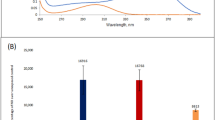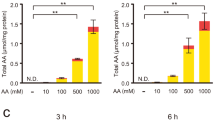Abstract.
Objective and Design: Exposure to UV radiation is responsible for skin erythema and inflammation. PGE2 is an important inflammatory mediator involved in this process and vascular endothelial growth factor (VEGF) is a potent vascular permeability factor mainly produced by epidermal keratinocytes. This study was aimed at determining whether UVB/A1 radiation and prostaglandin E2 (PGE2) could modulate the production of VEGF by cultured dermal human fibroblasts (HF) in comparison to keratinocytes (HK). Materials and Methods: The skin cells derived from foreskin, were cultured in defined medium before treatment by either UVB/A1radiation, or stimulation by addition of PGE2 (10-8 to 10-5 M). The expression of VEGF in cultured fibroblasts and keratinocytes was evaluated at the mRNA (RT-PCR) and protein levels (ELISA). Results: The basal level of VEGF was lower in HF than in HK. Both UVB and UVA1 radiation strongly up-regulated VEGF mRNA and protein in HF whereas UVB but not UVA1 radiation induced a VEGF increase in HK only at the protein level. UVA1, when associated with UVB radiation, showed an additive effect on VEGF secretion in HF but not in HK. PGE2 increased in a dose-dependent manner the expression of VEGF in HF but not in HK. Indomethacin as well as the antioxidant α-tocopherol did not reduce UV-induced enhanced secretion of VEGF by both fibroblasts and keratinocytes whereas pyrolidine dithiocarbamate exerted an inhibition of this overexpression. Conclusions: These results indicate different signaling pathways in the PGE2 and UV-induced regulation of VEGF in dermal fibroblasts and epidermal keratinocytes. They also suggest a role for VEGF from both fibroblasts and keratinocytes in the UV-induced erythema, independent of PGE2. A dermal overexpression of VEGF by fibroblasts from UV-irradiated skin may contribute to dilated microvasculature, a feature of skin photoaging and more generally, to a more permissive stroma to tumor formation than unexposed skin.
Similar content being viewed by others
Author information
Authors and Affiliations
Additional information
Received 12 October 2000; returned for revision 18 April 2001, accepted by I. Ahnfelt-Rønne 4 May 2001
Rights and permissions
About this article
Cite this article
Trompezinski, S., Pernet, I., Schmitt, D. et al. UV radiation and prostaglandin E2 up-regulate vascular endothelial growth factor (VEGF) in cultured human fibroblasts. Inflamm. res. 50, 422–427 (2001). https://doi.org/10.1007/PL00000265
Issue Date:
DOI: https://doi.org/10.1007/PL00000265




